Location :
The Kailasanathar Siva temple is located in the temple town of Kanchipuram in Tamil Nadu, India. It was built great by the Pallavas in the early 8th century CE. It is famous for its splendid vimana. It also contains numerous panels showing lord Siva as Nataraja in various postures. This temple was built by Pallava King Narasimhavarman II (Rajasimhan).
Significance of the temple
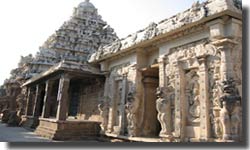
The temple is adorned with many interesting sculptures of Lord Shiva in 64 poses, which presents a picture of different aspects of mythology. The fresco paintings embellish the inner walls of the shrine. The temple is unique in its architecture and is viewed more as an architectural wonder than as a holy place.
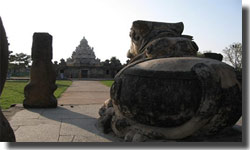
Shiva Lilarnavam, Sambu Nadaname and such other literatures have exquisitely described the dances of Lord Shiva. Come straight to this temple and walk around the corridor. The cells on the periphery are small, while on the inner wall they are big with big images.
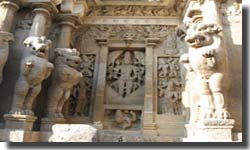
Gangadara who stemmed the force of Ganga in his locks; Brahma-Chiracheda murthi who clipped off the fifth head of Brahma by his nail; "Vishapaharana" who arrested the poison Alahala in his throat; Gowriprasada who changed the colour from black to a golden hue; "Chanda Thandavan" with "Rowdram" (anger), "Karunai" (mercy), "Sringar" (amour), "Bayam" (fear), "Nagai" (Smile) and "Veeryam" (Valour) exhibited in his face, Thiripurantakan who without a single weapon destroyed the Asuras (demons) with his mere smile, Kritarjunamurti in the guise of a hunter, Chandesvara Anugraha, LinGodbavar, Bairava, Harihara are some the innumerable forms of Lord Shiva that can be witnessed here.
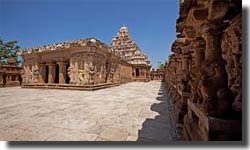
A huge kneeling Nandi stands in the front facing the temple and a look at it clearly indicates it must have been painted in gorgeous colours once. In those days, all the sculptures were painted brightly. Now only traces are seen; and they are not inferior to those of Ajanta.
Though the construction of the Kailasanathar Temple was started by Rajasimha Pallava, it was his son Mahendra Varma Pallava who completed the construction. Local people believed that the temple of Kailasanathar served the purpose of a shelter for the king during the time of the battles. The origin or the legend behind building this temple is lost in the distant past.
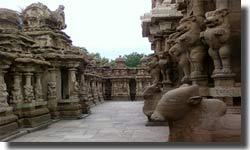
Kanchipuram's Kailasanathar Temple can be described as the successor of the rock temples at Mahabalipuram. The bases of the pillars in Mahabalipuram temples have seated lions while the Kailasanathar temple have confident grimacing lions standing on their hind legs.
| It is learnt that the Shiva lingam has the flat stripes inside the temple which is specialty of this lingam. It is 10 feet high and the temple closes by 6 to 6:30 PM daily. There is a story behind this early closure. Temple priests narrate it to the visitors. | Nearby tourist places to Kailasnathar Temple
Chennai Kanchipuram Pattadakal |
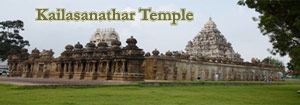 |
How to Reach the Temple
- Through Airways -Chennai is the nearest airport to Kanchipuram. One can take flights for most of the important Indian cities and cities abroad from Chennai.
- Through Railways- the Trains for Kanchipuram are available from Chennai, Chengalpattu, Tirupati, and Bangalore.
- Through Roadways- Kanchipuram is 75-km away from Chennai and is well connected by a network of roads. There are frequent buses from the city to Chennai, Bangalore and other places.
- For local transportation, bicycles can be hired from the shops near the bus stand. Cycle rickshaws and auto rickshaws are also available on hire to move in and around the city.



